Table of Contents
- Must-Have CMS Features for SEO
- Does Your CMS Impact SEO?
- Elements of SEO for Optimizing Your Website
- Best CMS Platforms for SEO
Does Your CMS Impact SEO?
The short answer is yes. The longer answer is your CMS can impact SEO because the features your CMS offers (or doesn’t offer) impact the SEO of your website.
For example, your CMS may or may not offer the ability to index, add meta descriptions, image alt text, customize your URL, tools for blogging and editing, create sitemaps, and more.
All of these features impact the SEO of your website, and yet not every CMS is going to have the same list of features, or even if they have the ability to use a feature, some may require more technical website-building knowledge than you’re cut out for.
If you’re worried that your current website is lacking in optimization, check out HubSpot’s Website Grader or the AI Search Grader to get a quick insight into how you’re doing.
Elements of SEO for Optimizing Your Website
I’ve found that there are two major ways you can optimize your website:
- Technical SEO: This refers to elements that you don’t see, like site structure, load time, and XML sitemaps.
- On-page SEO: This refers to elements you do see, like keywords, meta descriptions, links, and images.
Let’s take a closer look at each of these elements and how they help either your on-page or technical SEO. Then, we’ll explore some of the best CMS systems for SEO.
1. Customizable Page Elements
Your CMS should let you customize the title, meta description, and image alt text of your posts and pages. These are essential to your on-page SEO. By including your target keywords in different spots, you’ll help visitors and search engines better understand what the page is about, which, in turn, improves your ability to rank.
I suggest sticking to a word limit for titles and meta descriptions (60 characters for titles and 160 for meta descriptions). Ideally, your CMS will count these characters for you, so you don’t have to.
2. URL Settings
Your URL structure is another crucial part of your site. Search engines, like readers, don’t like reading lengthy strings of words with complex structures. To keep your URLs short and descriptive, you’ll want to include only your target keywords.
To fully optimize your on-page SEO, you’ll need your CMS to let you customize your URLs.
3. Blogging Tools
Blogs are one of the primary forms of media used in content strategies. That’s why you should pick a platform with blogging tools and templates to help you get started. A drag-and-drop editor with modules for images, videos, call-to-action buttons, and more can help you easily and quickly create engaging blog posts.
4. Internal Linking
Internal links are another essential on-page SEO element. Linking to your related content will accomplish two things. First, it’ll help search engines find all of the content you own on a particular topic, which improves your chances of ranking for the keywords associated with that topic. Second, linking to other helpful posts and pages can improve the visitor experience and convince them to stay on your site longer.
You can link your pages manually every time you create a new post, but a CMS platform with a built-in internal linking tool or add-on can help automate this process.
5. Taxonomy
Taxonomy is another way to help both site engines and readers understand the structure of your site and quickly find the content they’re looking for. Most CMS systems will offer categories and tags for organizing your content. With categories, you can separate your pages and posts into broad categories. You can then get more specific with tags.
Some CMS systems will offer more advanced taxonomy options, like topic clusters.
6. Navigation Menus
Navigation menus are also an essential element of your site structure. With a navigation menu, you can organize the multiple pages on your site in a way that allows search engines to easily crawl them and readers to find them.
Take a look at Vertical Measures’ navigation menu before its website redesign. It was linking to so many similar category pages that it was difficult for visitors to find the exact posts they were looking for. So, the company renamed, reorganized, and consolidated fourteen categories into eight for what I believe to be a much cleaner look.

7. 301 Redirects
Ideally, your CMS will make it easy to create 301 redirects. Redirects are an essential part of any content audit strategy. For example, when you find outdated and redundant pages that bring in virtually zero qualified traffic for your business, you can redirect them rather than delete them.
Redirects not only allow you to avoid broken links and 404 error pages — but they also ensure that any visitors or search engine crawlers that end up on those pages are sent to existing content on your site. That’s why setting up 301 redirects is an important step in retaining traffic and rankings.
8. Responsive Themes
Mobile devices account for more than 60% of organic search engine visits. And for this valuable majority of search queries, Google displays the mobile-friendly results first.
To capture this mobile traffic, you need to create a responsive site. You can make that easy by choosing a CMS with mobile-optimized themes and templates. This will ensure every post and page published on your site is optimized for all devices.
9. SSL Certification
An SSL certificate is a standard security technology for securing information between a visitor’s browser and your website. Search engines prioritize secure sites; In fact, Google announced that SSL would be a ranking factor — and visitors prefer it because it ensures their sensitive information, like passwords and payment information, remains private.
In my opinion, the best-hosted platforms include an SSL certificate in their plans, as do third-party hosting providers for open-source CMS platforms. That way, you don’t have to worry about installing, purchasing, or renewing an SSL certificate separately.
10. XML Sitemaps
XML sitemaps are exactly what they sound like: maps for websites. These files list every single page on your website so that search engines can easily find, crawl, and index your content. These files list every single page on your website so that search engines can easily find, crawl, and index your content.
You can create a sitemap manually, but the process requires a bit of coding. Ideally, your CMS will create one for you. Or, at least, you can install a sitemap plugin to do the work for you.
11. Analytics Tools
You have to invest a lot of time and effort into optimizing your site’s SEO strategy. To make sure you’re investing in the right strategies, you want to track certain metrics daily, weekly, and/or monthly. To measure your success with SEO, you’ll want to track metrics like your:
- Overall organic traffic
- Indexed pages
- Leads
- Keywords
- Inbound links
I’ve found that using a CMS that can create a dashboard with these and more metrics will ensure you understand what parts of your SEO strategy are working and what could be improved.
Now that we understand the top CMS features that matter for SEO, let’s evaluate the functionality of the platforms below.
Best CMS Platforms for SEO
To help you select the CMS platform that will help meet your SEO needs and goals, we’ll take an in-depth look at some of the most popular solutions below.
In the meantime, if you’re concerned that your current website isn’t doing well SEO-wise, check out HubSpot’s website grader and the AI search grader to see how you’re doing. This might give you insight into whether you have the correct CMS for your needs or not.
1. Content Hub
The Content Hub is one of the most powerful platforms for creating and optimizing small, medium, and enterprise websites — and it’s one of my favorites, too.
In addition to offering blogging tools, responsive themes, built-in SSL certification, and an auto-generated sitemap, HubSpot’s Content Hub offers auto-generated suggestions for optimizing your content, robust analytics, and several features to speed up your site. It also provides multiple tools for:
Not only can you customize the on-page SEO elements of a specific page or post, but HubSpot will also help by offering SEO recommendations as you write. For example, recommendations will include the long-tail keyword in the title; they’ll tell you to add a meta description and include two subtopics.
I appreciate that, on pages and blog posts, the Optimize tab will also show what SEO best practices you’ve successfully followed — like adding image alt text, staying within an optimal word count, and hitting a solid link count.
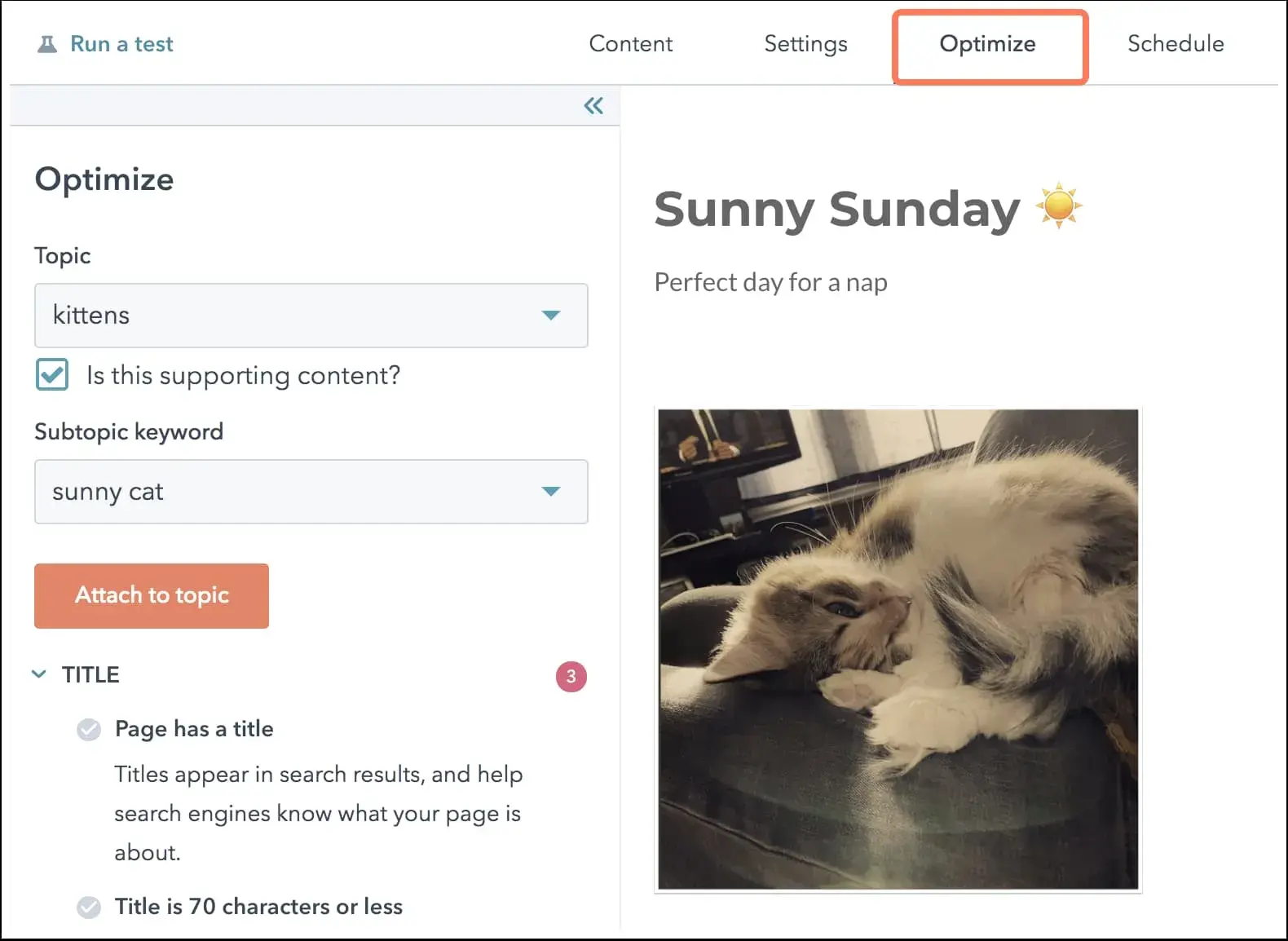
Before you publish, you can change the URL slug, add a tag, meta description, and featured image, and preview how the page or post will appear on mobile, tablet, and desktop.

Once published, you can view the performance details of individual posts and pages. For example, in the Performance tab, you can select the date range to analyze data — like views, submissions, new contacts, average bounce rate, exit rate, and more, over a specific period. You can also customize this dashboard by removing, reordering, or adding different metrics.
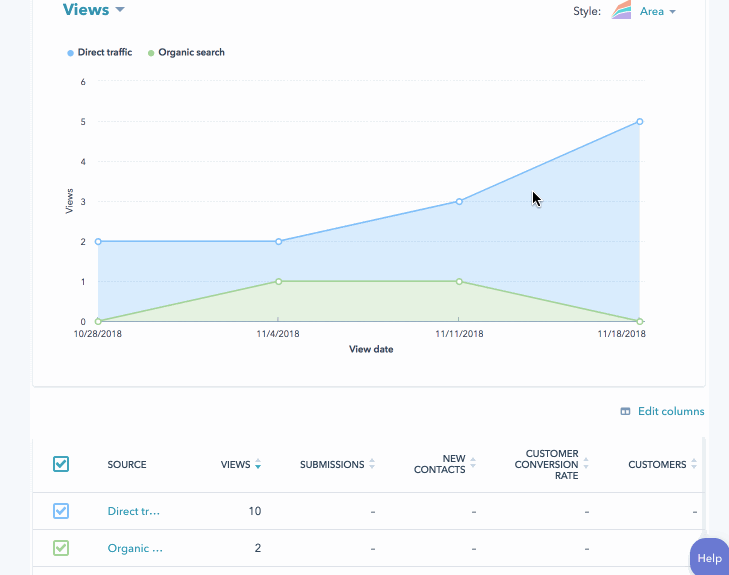
I also appreciate that if a post or page isn’t performing as well as expected, you can view the Optimize tab to see additional SEO recommendations you can implement.

Content Hub’s Recommendations tool can also scan your entire domain and associated subdomains, whether they’re hosted on HubSpot or another CMS, for a broader look at your SEO opportunities.
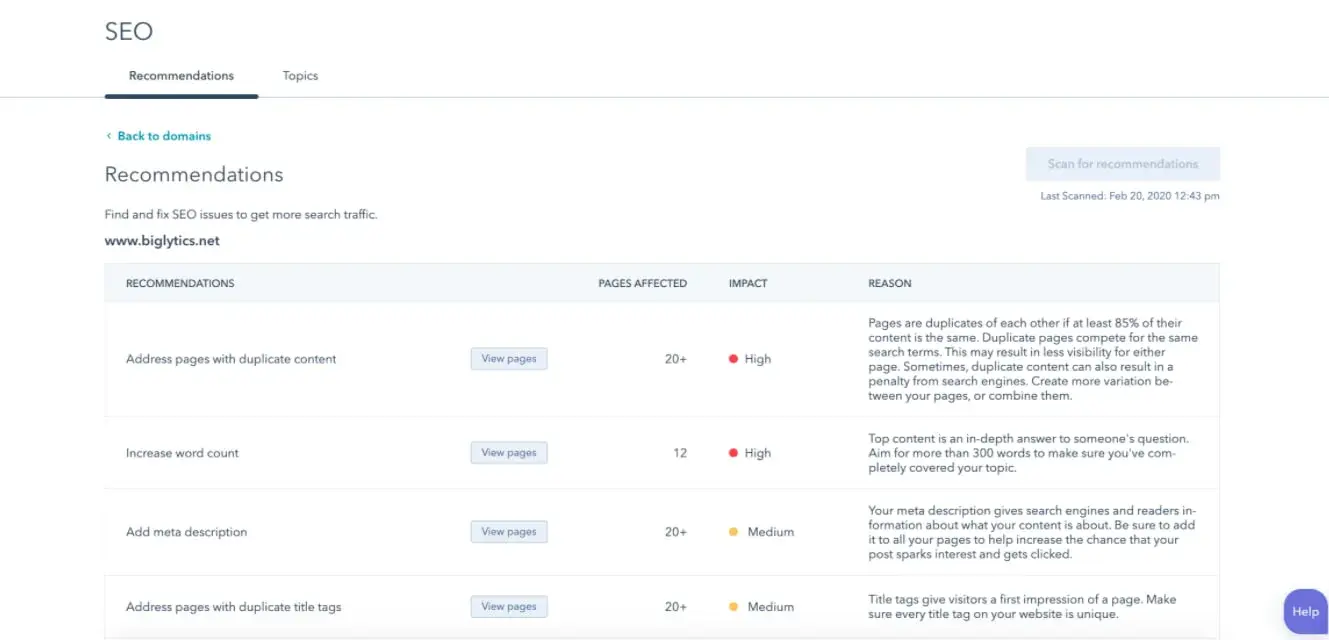
Finally, Content Hub provides a number of built-in features to ensure your website loads fast. This includes a global CDN, automatic image compression and optimization, minified JavaScript, combined CSS files, and page caching.
Content Hub Pros
- Integrates seamlessly with HubSpot’s CRM platform, including Marketing Hub, Service Hub, and Sales Hub
- Plan includes an SSL certificate
- Sitemap auto-generated for you
- Useful editor UI for creating navigation menus
- Offers SEO-friendly website themes that can make it easy to create and launch a site
- Gives SEO recommendations based on performance without requiring an extension
- Includes A/B testing capabilities so that you can see which pages rank better and why
- Robust support options, including a direct phone line and a knowledge base
Content Hub Cons
- No free version is available, though a trial is offered
- Pricing may be steep for local businesses, freelancers, and sole proprietors
- Migration may be lengthy depending on your previous CMS provider
- Hands-on onboarding costs $800 (one-time fee)
2. WordPress
I like WordPress because it’s SEO-friendly, and this software is behind over 40% of all websites. Like Content Hub, WordPress enables you to add titles, image alt-text, meta descriptions, headings, and custom URLs to your posts and pages.
You can also choose from an even larger selection of responsive themes in the official WordPress directory and other third-party marketplaces to design your site.
You can use a solution like the free Elementor Page Builder, which offers mobile editing if you’re looking for even more control over the appearance of your site on different devices.
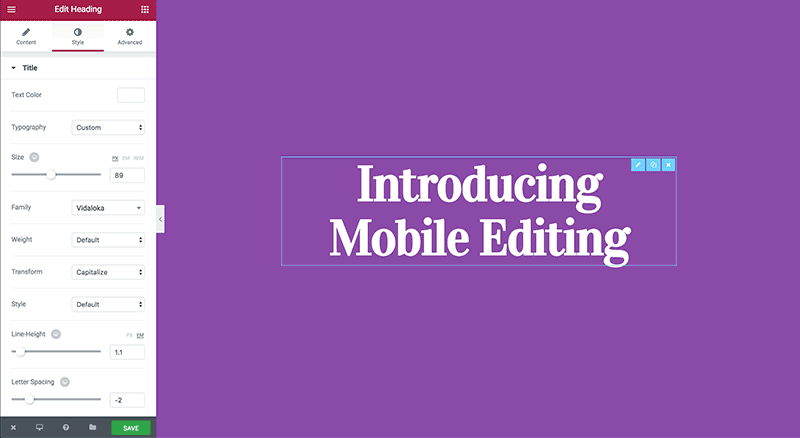
Using WordPress, you can also add a complex blog to your site, change your permalink settings, create and manage navigation menus, and use categories and tags to organize your content right in your dashboard.

I found that the similarities between the experience of optimizing your site on WordPress and Content Hub end here, however.
WordPress is lacking in functionality beyond the standard SEO features mentioned above. However, that doesn’t mean you’re simply left with what WordPress provides out of the box.
To get tips on SEO best practices as you write, set up redirects, generate an XML sitemap, drill down into analytics, and speed up your site, you can download and install the appropriate WordPress plugins.
For example, you can install the Yoast SEO plugin to help you with on-page SEO. Offering a free and premium version, this plugin will provide suggestions for creating readable text, using your keywords, optimizing your meta descriptions and image alt text, and adding internal links.
Here’s a look at the results of a readability check in Yoast SEO.

Other plugins like RankMath, Smush, WP Rocket, Google XML Sitemaps, and Redirection will simplify or automate the process of optimizing your images, page speed, XML sitemaps, and redirects.
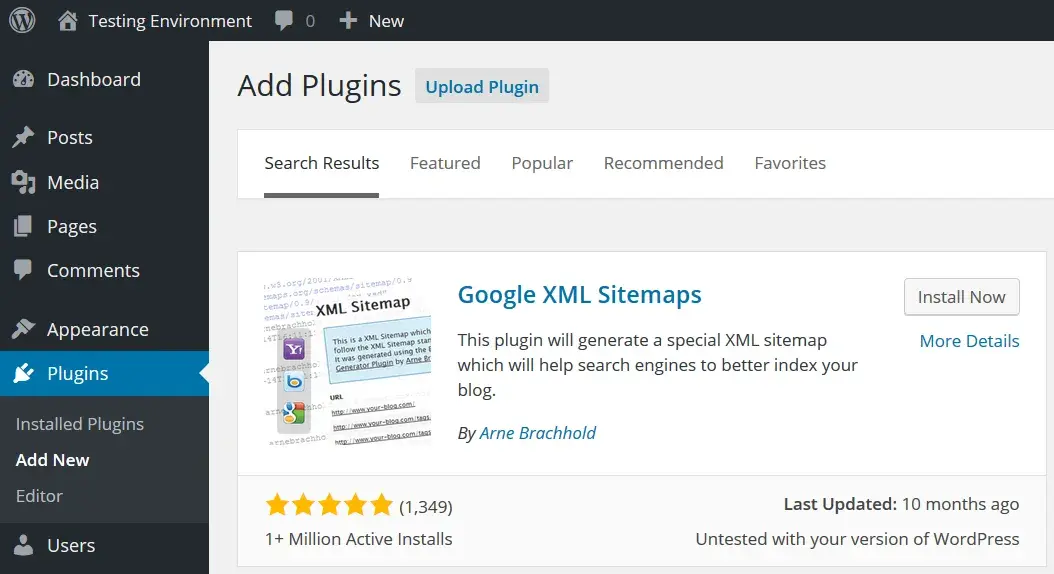
Unfortunately, downloading and purchasing these tools will require time and money. However, some hosting providers, such as Hostinger, offer managed WordPress hosting, which includes essential SEO tools like LiteSpeed Cache and a pre-installed CDN. They also provide automatic updates and free backups, so you don’t have to worry about manually maintaining your site.
WordPress Pros
- You can use and install WordPress without speaking to a sales team
- Large library of plugins to choose from, many of which are specifically designed for SEO
- Thousands of responsive themes available
- Easy-to-use and intuitive interface for most SEO marketers
- Highly customizable with capabilities for editing the site’s theme files, HTML code, and CSS code
WordPress Cons
- Out-of-the-box, WordPress lacks standard SEO functionalities like web analytics
- Have to install at least one SEO plugin to make up for the lack of built-in functionality
- Installing too many plugins and extensions can cause page speed to increase
- The built-in page editor can be un-intuitive and could warrant the installation of a page editor plugin
- Not all themes are SEO-friendly or receive frequent-enough updates
- No dedicated customer support in case something goes wrong; you’d have to work with a freelance developer or fix it on your own
3. Magento
If you’re looking to build and optimize an online store for search, consider Magento.
Magento will provide a similar experience to WordPress. There are some standard SEO features built directly into the platform, but for more advanced functionality, you’ll have to download an extension.
For example, with this open-source ecommerce platform, you can select a responsive theme, add meta descriptions to all your product pages, and optimize the alt text of product images. You can also:
- Create an XML sitemap for your site
- Add navigation menus
- Remove any duplicate content
- Set your checkout, account, cart, and admin pages to “nofollow”
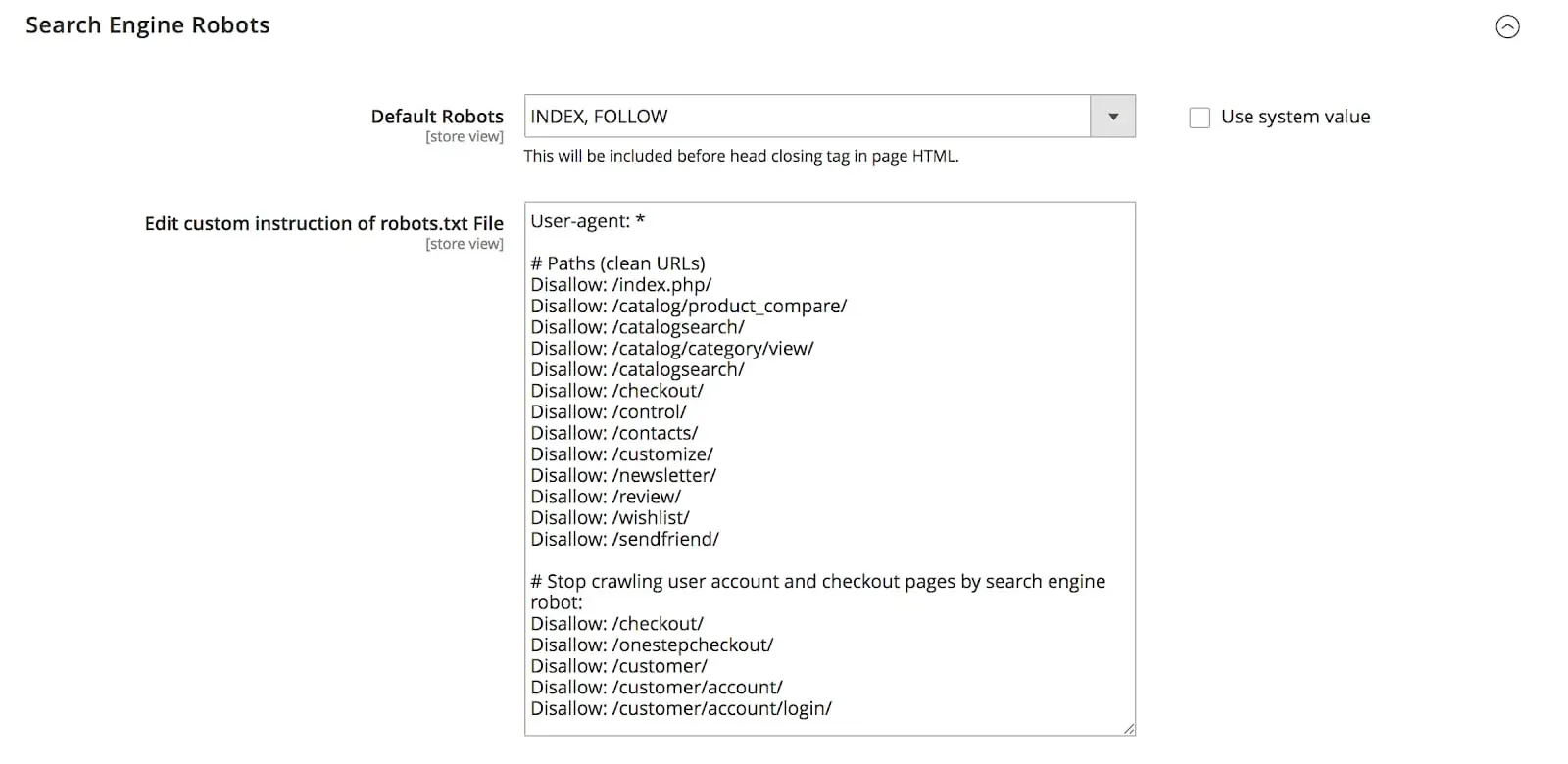
You can carry out these tasks manually if you have SEO experience or the time to learn best practices. Or, you can download extensions to automate and simplify these tasks, like:
- SEO Content Optimization by ReloadSEO
- Magento SEO Suite Pro extension
- Advanced SEO Suite by Mirasvit
- Manadev Layered Navigation SEO
- Creare’s Free Magento SEO Extension
Take a look at Reload’s dashboard as an example. You’ll see sections for keyword research, content optimization, backlinks, and store monitoring — all of which are crucial to your store’s SEO.
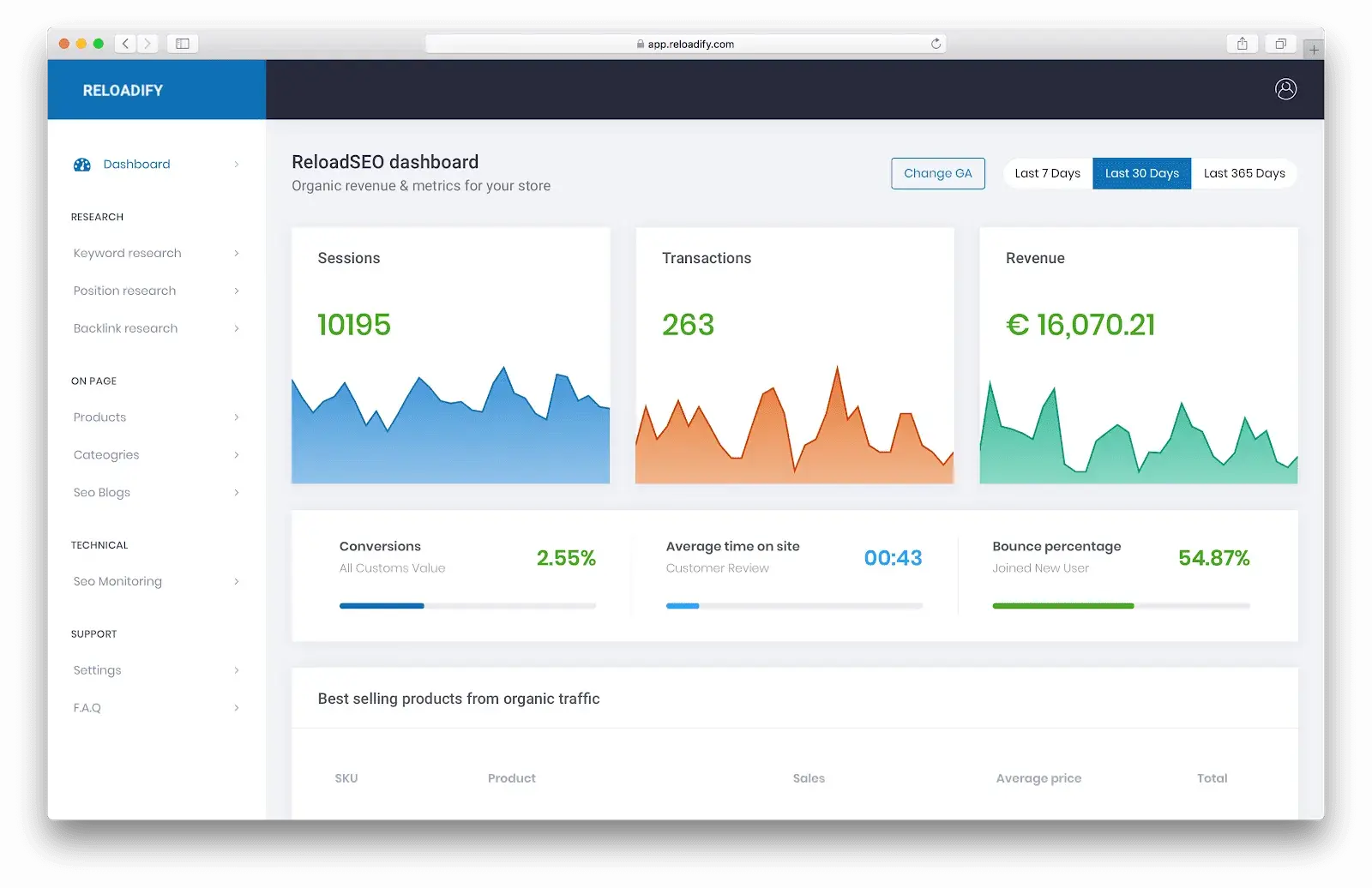
Magento Pros
- You can remove the “Category” subfolder from your product pages’s URLs, making the URLs more SEO- and user-friendly
- Magento gives you the ability to add descriptive meta descriptions to your product pages
- You can set up canonical URLs, preventing duplicate content and self-cannibalization
- An XML sitemap is included out-of-the-box
- You can include personalized product recommendation carousels on product pages, which will increase dwell time, a major SEO ranking factor
- Large integration marketplace with many SEO apps and tools
Magento Cons
- Requires extensions to offer full SEO capabilities and tools
- You can’t create meta information templates for product pages unless you purchase an extension
- While it does create an XML sitemap for your site, Magento doesn’t create an HTML sitemap, which is beneficial from a user experience standpoint
- No built-in blog functionality — you’ll need to install an extension
4. Joomla
One thing I like about Joomla is that it balances power with flexibility, sitting somewhere between WordPress and Magento or Drupal. It’s also the most popular CMS in use today after WordPress.
In many ways, Joomla is similar to WordPress — it offers software extensions to extend the functionality of your website, and templates to customize your site’s visuals. Joomla also provides more site and content management tools out of the box than WordPress.
However, I find that the process of installing them and configuring other aspects of your site is not as straightforward as WordPress. It’s a tradeoff of convenience for capability.
As far as SEO features go, Joomla is a solid choice for optimizing larger business and ecommerce websites. The CMS allows users to easily make key SEO tweaks without extensions, like writing meta descriptions and titles, enabling gzip compression, and managing URLs and site architecture, the latter being especially relevant to bigger sites that routinely add and remove content.
Aside from native features, Joomla’s extension directory contains a wealth of SEO add-ons to change how your URLs are generated, structuring your content for Google snippets, creating an XML sitemap, and implementing redirects.
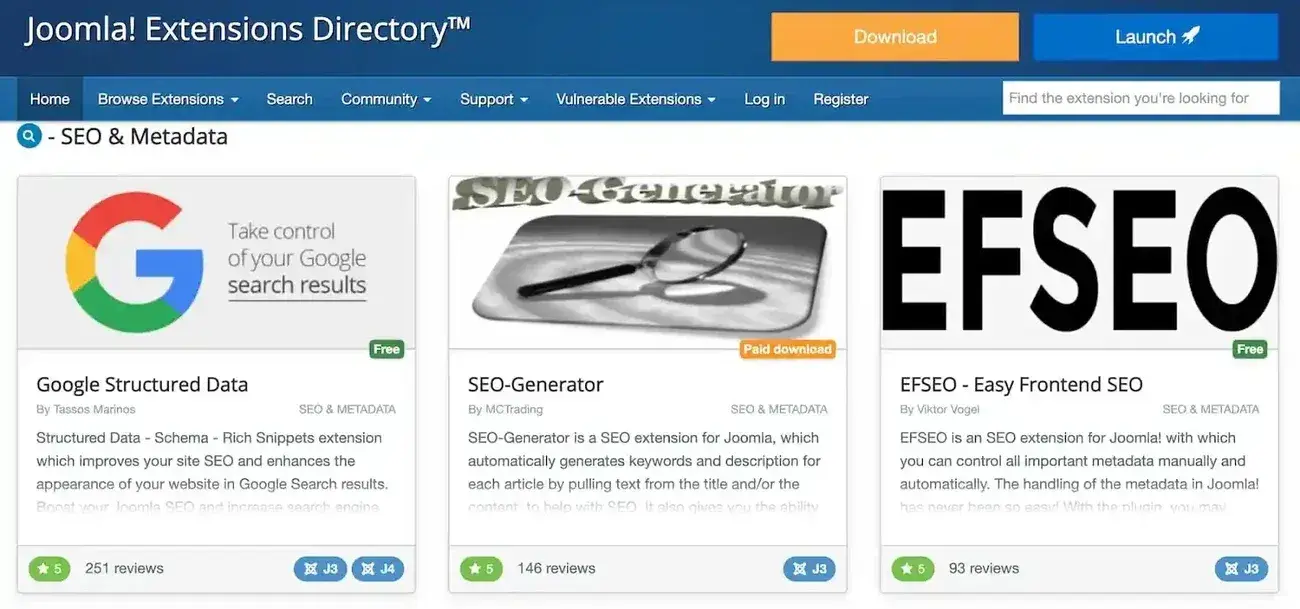
Joomla Pros
- More in-house SEO options than other CMSs while remaining relatively user-friendly and codeless
- Joomla is considered one of the faster content management systems, one of the most important factors in search ranking and user experience
- Hands-off caching for your site’s pages, further boosting performance
- Diverse extension library to make SEO tweaks with minimal or no code editing
- Automatic gzip compression, no extension required
- Joomla templates are responsive by default
- Extensions allow canonical URL designation to help search engines locate the most relevant version of a page on your site
Joomla Cons
- Joomla’s wider range of features and less intuitive interface may pose a challenge to those transitioning from WordPress or an all-in-one website platform
- XML sitemaps require a plugin to generate and submit
- SSL certificate is not included and must be installed manually via file edits
- To enable crawling of images and other media, manual edits to the robots.txt file are required
5. Adobe Experience Manager
If your enterprise uses Adobe Creative Cloud, keep Adobe Experience Manager top-of-mind when searching for an SEO-friendly CMS. I have a lot of experience with AEM, as it’s the primary CMS I’ve used in past roles.
I will say, with its price point and technical knowledge needed, this might not be your best option if you’re a small business. If you’re a medium to large business that has the workforce to run AEM, then this might be the CMS for you. But, be forewarned, I also would not choose AEM if my team didn’t have a designated graphic designer and someone familiar with coding.
With Adobe Experience Manager, you can create SEO-friendly URLs, assign canonical tags, build an XML sitemap, create 301 redirects, include breadcrumbs, and use robots.txt files to prevent indexing of private or development-stage pages.
You can also include meta descriptions and edit the HTML page title so that it’s SEO-optimized. (Some CMS platforms automatically create an unchangeable title based on the page’s H1.)
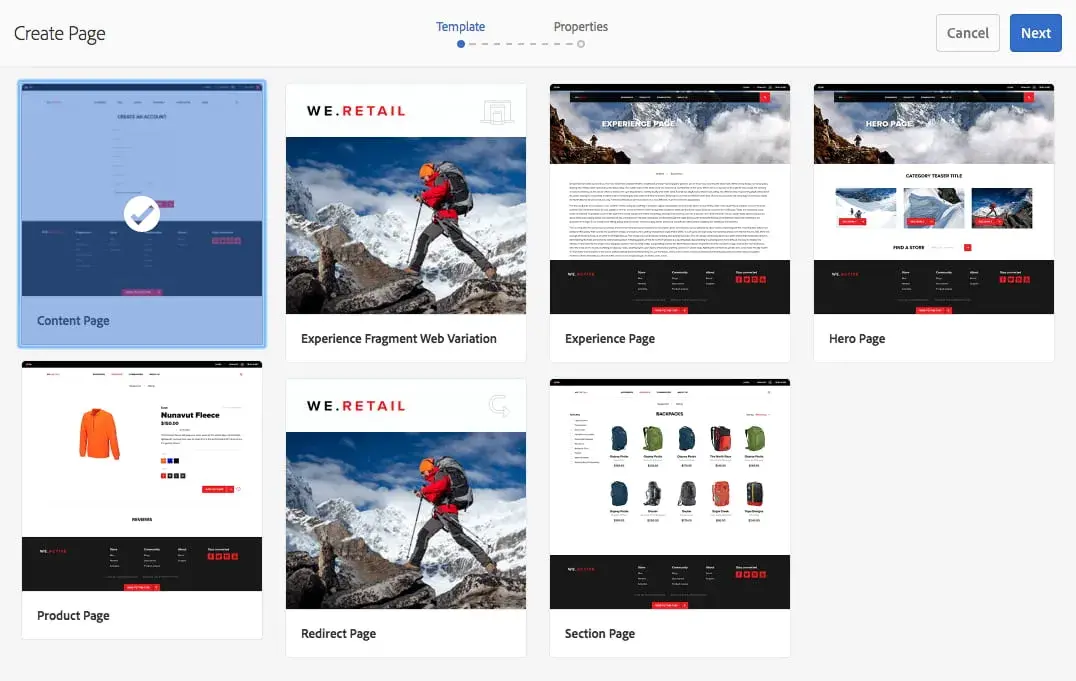
Other notable features include a drag-and-drop interface, built-in responsive design, page template editor, responsive form creator, and single-page web app creator.
You can also integrate the CMS natively with Creative Cloud. I do think that this CMS is a great option for Adobe Creative Cloud users who would like to marry their asset creation efforts with their content management efforts.
For seamless integration, Adobe provides a list of best practices for integrating Creative Cloud and AEM.
Adobe Experience Manager Pros
- Offers a multitude of built-in tools (vanity URLs, XML sitemaps, breadcrumbs) that would require a plugin or extension in other platforms
- Drag-and-drop editor allows you to create a responsive, SEO-optimized website with little to no coding
- Critical out-of-the-box SEO components include page titles, robots.txt files, canonical tags, 301 redirects, page navigation, and search
- You can create image presets with a set compression rate, ensuring that large images don’t slow down your site
- Includes a blog feature that allows you to create informational, SEO-optimized content
Adobe Experience Manager Cons
- Pricing is not available on Adobe’s website, but it’s rumored to cost between $100,000 and $200,000
- Onboarding can take months, making it a poor fit for those who need a website quickly
- Steep learning curve to configure the platform according to SEO best practices
6. Wix
I think Wix is a great option for small businesses, freelancers, and entrepreneurs to launch a website quickly and easily, emphasizing simplicity and drag-and-drop building. As such, Wix helps you cover the SEO essentials on your website without getting too deep in the weeds.
As a Wix user, your main SEO resource will be Wix SEO Wiz, a knowledge base that explains how to build and publish a website capable of competing in the SERPs. Use it to evaluate your site’s SEO, discover useful tips, and learn how to improve it on the Wix platform.

I like that Wix lets you handle SEO essentials from your dashboard. This includes alternative text for images, SSL, sitemaps (though you’ll need to resubmit and manage your sitemap through Google Search Console), canonical URLs, redirects, meta descriptions, and URL tidying.

Still, if you’re a larger business or one looking to implement advanced SEO, Wix probably shouldn’t be your go-to CMS, as it’s better suited for and more reputable among small websites that aren’t looking to scale significantly.
While you can incorporate schemas and modify robots.txt, I’ve found that’s as sophisticated as it gets out of the box.
Wix Pros
- All-in-one, easy-to-use platform tailored for beginners to implement SEO at a high level
- SEO Wiz is a valuable resource for new website owners to learn the basics and make tweaks to their sites
- Fundamental SEO features are available through the dashboard, and no extensions are needed
- Wix sites are SSL-protected
- Automatic XML sitemap creation and submission to Google Search Console
Wix Cons
- Ultimately, Wix was made for individuals and small teams with limited to no prior coding or SEO knowledge, meaning it’s much more limited than an open-source tool
- Wix doesn’t let you change your site’s template once it’s been applied to your website, so choose carefully
- Wix has been known to create pages that are bloated with code and may be slower than competitors as a result
- Not all Wix site templates are guaranteed responsive
7. Shopify
Those in need of an ecommerce site platform have probably heard of Shopify, the highly popular website platform for online stores. On top of its wealth of built-in ecommerce tools, Shopify does enough to make sure users, even beginners, follow SEO best practices.
I think Shopify is great for individuals and small websites in need of a simple site with minimal hands-on customizations.
In exchange, the platform is known for its simplicity — everything from designs to hosting is taken care of, including SEO fundamentals.
With Shopify, you can target keywords, add alt text to media, optimize your website structure, create redirects, create XML sitemaps, manage canonical URLs that are generated for you, and choose from its library of responsive themes.


Those new to all of this can get help from Shopify’s thorough documentation. Plus, Shopify has partnered with the CDN provider Cloudflare to improve load times across Shopify sites.
However, I’ve found that there are drawbacks too: You can’t edit robots.txt directly, and there’s no native way to edit your XML sitemap. You also need to have a paid plan to get indexed by search engines — Shopify doesn’t allow indexing of trial sites.
Finally, you can’t remove the category subdirectory from your store’s URLs. In other words, you can’t remove “/products”, “/pages”, etc.
Shopify Pros
- Essential SEO tools are all included in Shopify, with no need for additional plugins that may slow your site
- Intuitive interface and options screen, saving you time that you might otherwise spend figuring out a simple process
- Automatically generated canonical URLs, robots.txt, and sitemaps
- All themes are responsive
- Pages load quickly thanks to an integrated CDN
Shopify Cons
- While Shopify makes a sitemap and a robots.txt file for you, you can’t edit these directly in the tool
- Indexing requires a paid plan — there is no free option beyond the trial.
- Limited customization of your URLs
- Relatively limited customization in terms of design and site functionality when compared to open-source tools
8. Squarespace
If you’re looking for a user-friendly CMS with templates that have already been created, Squarespace might be the right choice for you. A lot of marketers use Squarespace to reserve their domain, and then their journey with Squarespace ends there. However, Squarespace offers a lot more than just the ability to buy a domain for your website.
Using Squarespace, you can:
- Build a website
- Customize prebuilt templates
- Use prebuilt layouts
- Create navigation for different content types
- Duplicate pages and content
- Design using different free tools and free images from Unsplash
- Apply a custom CSS
- Create redirects and an internal search engine
- Optimize for mobile, including editing your website on the Squarespace mobile app
- Connect to Squarespace payments
For a list of all the features that Squarespace offers, check out their index. Squarespace might be the ideal CMS for a small business, like a food truck that needs to display basic information (menu, hours, etc.) and take online orders and payments.

Squarespace Pros
- Great integration with Squarespace payments on your website, making taking customer payments easy
- Easy-to-build a beautiful website using their premade templates
- Squarespace customer support is quick and helpful
- No need to transfer your domain over and pay two different fees if you reserve a domain with Squarespace
- Hardly any technical knowledge needed; Squarespace works great for those who don’t know how to code
Squarespace Cons
- Some customers complain that Squarespace updates can be difficult to navigate
- Some report that offering discounts and promo codes isn’t possible without customers entering their credit card information using Squarespace payments extension
- Limited customization; if you are familiar with coding, it may be frustrating to be so limited in what you can do on your website
- Some customers report that the design features and templates are pretty limited

Content Hub, WordPress, Magento, Joomla, Adobe Experience Manager, Wix, Shopify, and Squarespace are some of the best content management systems for SEO. Offering powerful features and vast opportunities for personalization, these CMS platforms will help you build a site that ranks.
Choosing the Best CMS for SEO
While exploring the above CMS options for SEO, I was surprised to find just how different each of the possible platforms are. Some are simple and straightforward but lack technical options, whereas it seems that the more technical a CMS platform becomes, the more it costs.
In my opinion, the size of your team and the expertise of those running your website should determine your CMS. While some content management systems are better for technical SEO, if you don’t have the manpower to run that type of CMS, you won’t be able to take advantage of the SEO options it presents.
Editor's note: This post was originally published in May 2020 and has been updated for comprehensiveness.
Content Management System








![20 Best Membership Website Builders and Platforms [+My Favorite Examples]](https://53.fs1.hubspotusercontent-na1.net/hubfs/53/14%20Best%20Membership%20Website%20Builders%20and%20Platforms%20in%202022%20%5B+%20Website%20Examples%5D.png)



